2023年中考英语复习 专题十三 主谓一致和特殊句式课件(共34张PPT)
文档属性
| 名称 | 2023年中考英语复习 专题十三 主谓一致和特殊句式课件(共34张PPT) |  | |
| 格式 | ppt | ||
| 文件大小 | 2.0MB | ||
| 资源类型 | 教案 | ||
| 版本资源 | 人教新目标(Go for it)版 | ||
| 科目 | 英语 | ||
| 更新时间 | 2023-06-11 15:24:18 | ||
图片预览

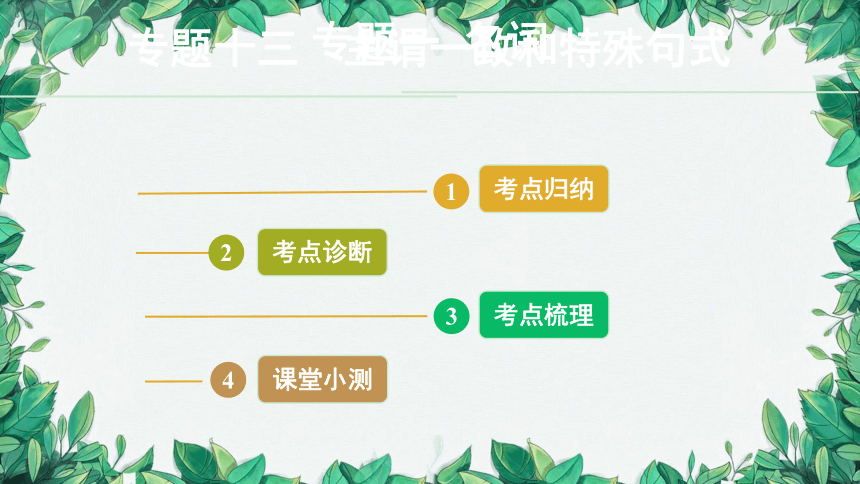
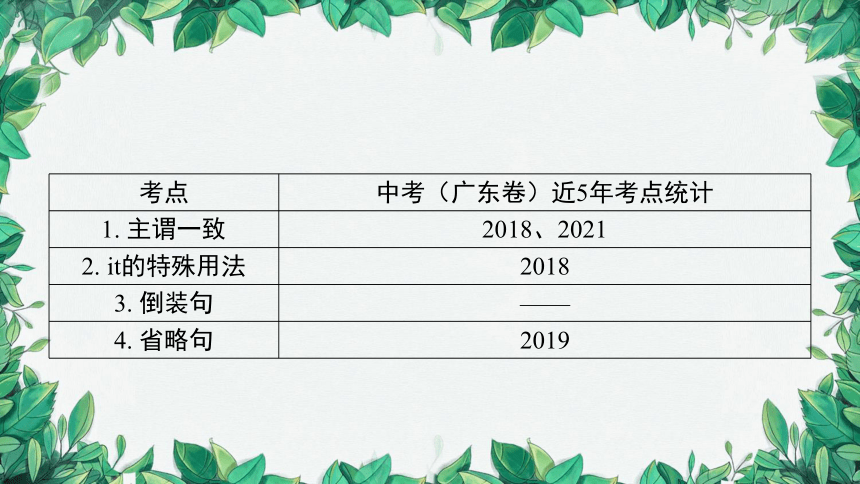
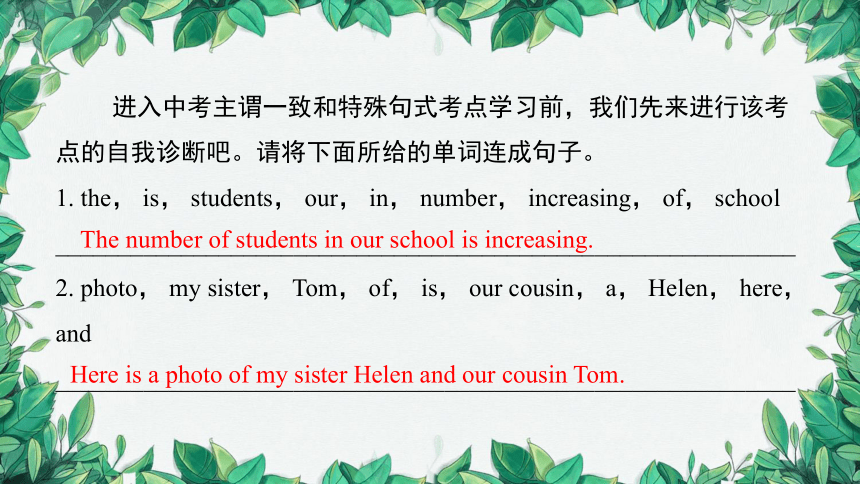
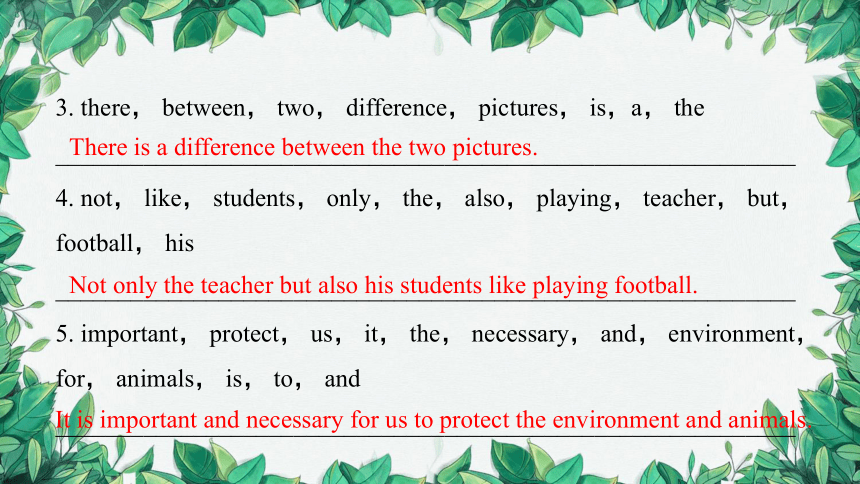
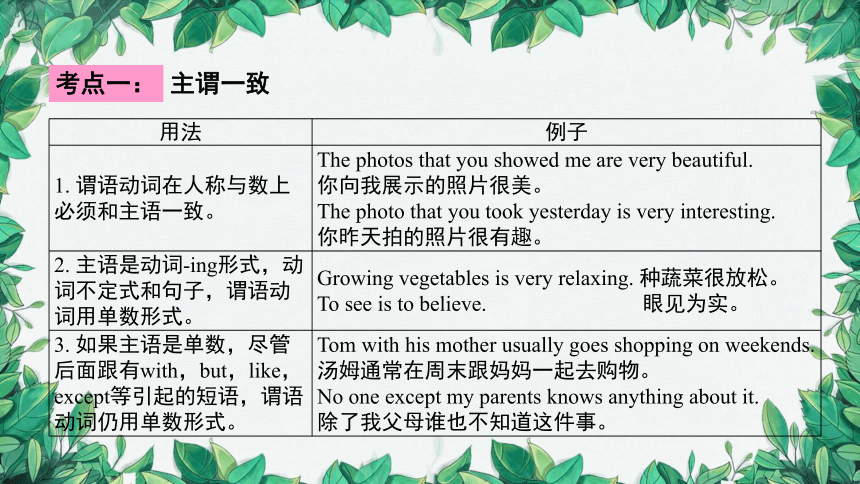
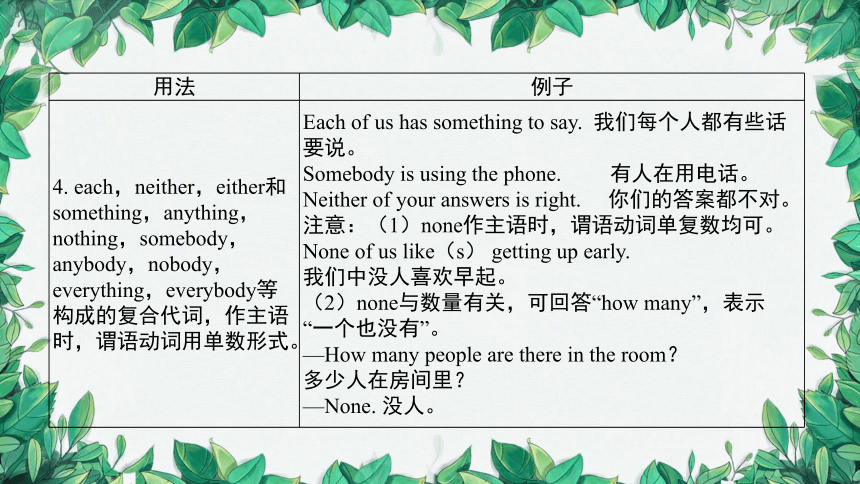
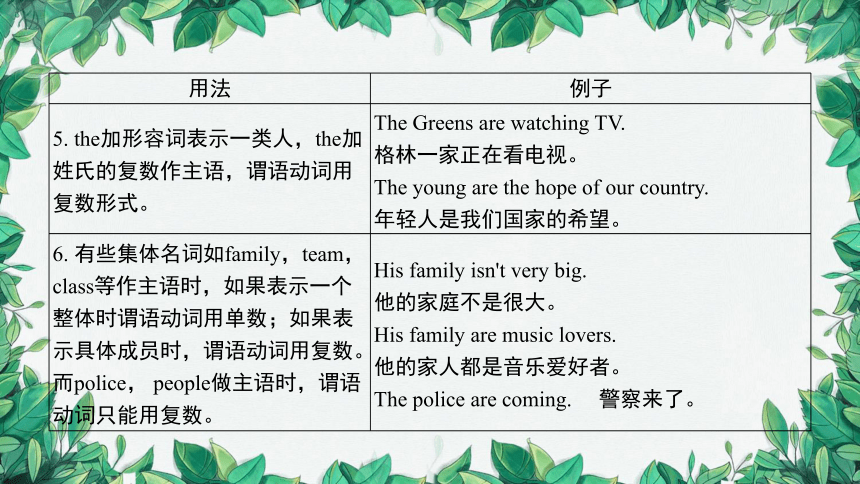
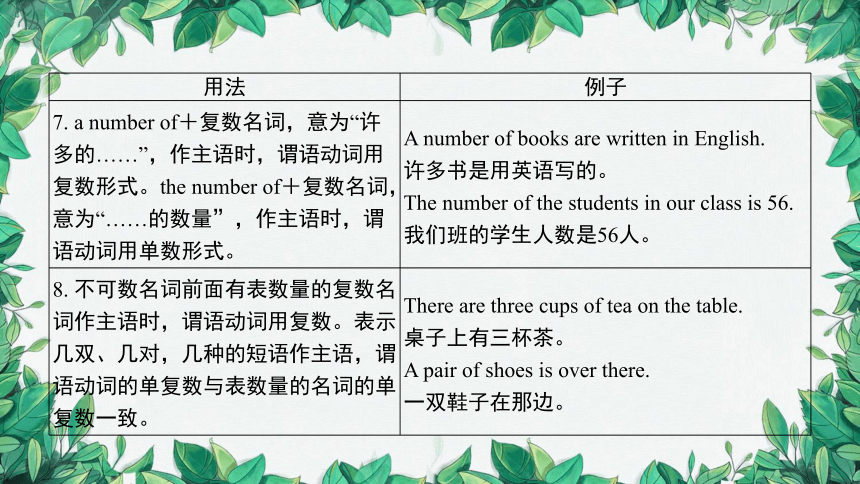
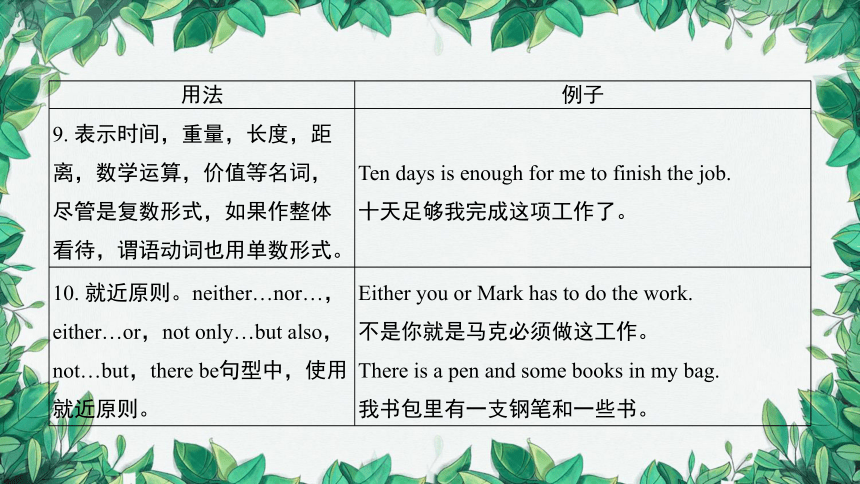
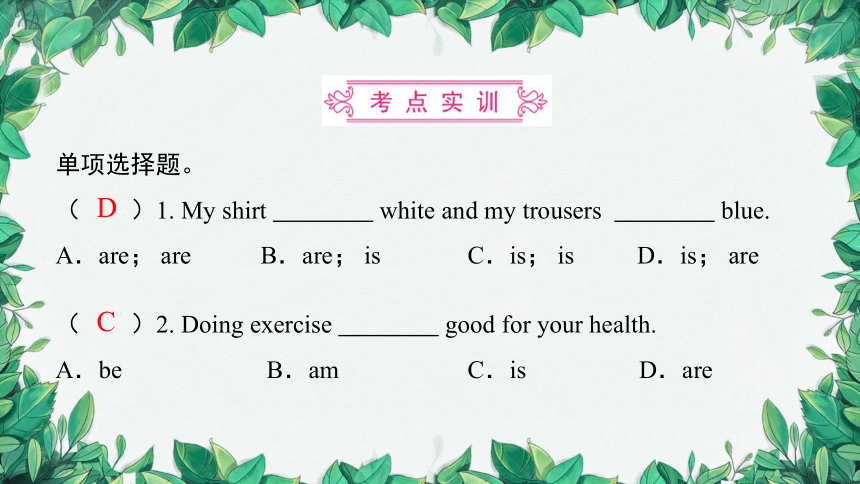
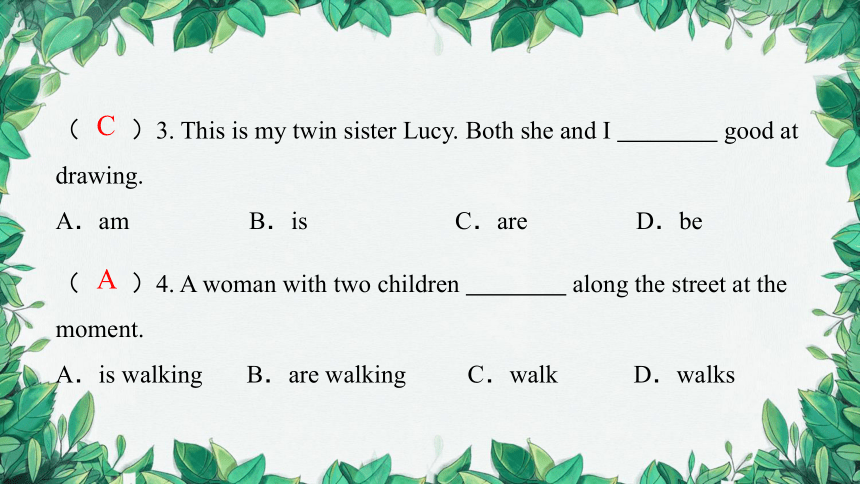
文档简介
(共34张PPT)
第一部分
语法专题训练
专题一 名词
1
考点归纳
2
考点诊断
3
考点梳理
4
专题十三 主谓一致和特殊句式
课堂小测
考点 中考(广东卷)近5年考点统计
1. 主谓一致 2018、2021
2. it的特殊用法 2018
3. 倒装句 ——
4. 省略句 2019
进入中考主谓一致和特殊句式考点学习前,我们先来进行该考点的自我诊断吧。请将下面所给的单词连成句子。
1. the, is, students, our, in, number, increasing, of, school
___________________________________________________________
2. photo, my sister, Tom, of, is, our cousin, a, Helen, here, and
___________________________________________________________
The number of students in our school is increasing.
Here is a photo of my sister Helen and our cousin Tom.
3. there, between, two, difference, pictures, is,a, the
___________________________________________________________
4. not, like, students, only, the, also, playing, teacher, but, football, his
___________________________________________________________
5. important, protect, us, it, the, necessary, and, environment, for, animals, is, to, and
___________________________________________________________
There is a difference between the two pictures.
Not only the teacher but also his students like playing football.
It is important and necessary for us to protect the environment and animals.
考点一:
主谓一致
用法 例子
1. 谓语动词在人称与数上必须和主语一致。 The photos that you showed me are very beautiful.
你向我展示的照片很美。
The photo that you took yesterday is very interesting.
你昨天拍的照片很有趣。
2. 主语是动词 ing形式,动词不定式和句子,谓语动词用单数形式。 Growing vegetables is very relaxing. 种蔬菜很放松。
To see is to believe. 眼见为实。
3. 如果主语是单数,尽管后面跟有with,but,like,except等引起的短语,谓语动词仍用单数形式。 Tom with his mother usually goes shopping on weekends.
汤姆通常在周末跟妈妈一起去购物。
No one except my parents knows anything about it.
除了我父母谁也不知道这件事。
用法 例子
4. each,neither,either和something,anything,nothing,somebody,anybody,nobody,everything,everybody等构成的复合代词,作主语时,谓语动词用单数形式。 Each of us has something to say. 我们每个人都有些话要说。
Somebody is using the phone. 有人在用电话。
Neither of your answers is right. 你们的答案都不对。
注意:(1)none作主语时,谓语动词单复数均可。
None of us like(s) getting up early.
我们中没人喜欢早起。
(2)none与数量有关,可回答“how many”,表示
“一个也没有”。
—How many people are there in the room?
多少人在房间里?
—None. 没人。
用法 例子
5. the加形容词表示一类人,the加姓氏的复数作主语,谓语动词用复数形式。 The Greens are watching TV.
格林一家正在看电视。
The young are the hope of our country.
年轻人是我们国家的希望。
6. 有些集体名词如family,team,class等作主语时,如果表示一个整体时谓语动词用单数;如果表示具体成员时,谓语动词用复数。而police, people做主语时,谓语动词只能用复数。 His family isn't very big.
他的家庭不是很大。
His family are music lovers.
他的家人都是音乐爱好者。
The police are coming. 警察来了。
用法 例子
7. a number of+复数名词,意为“许多的……”,作主语时,谓语动词用复数形式。the number of+复数名词,意为“……的数量”,作主语时,谓语动词用单数形式。 A number of books are written in English.
许多书是用英语写的。
The number of the students in our class is 56.
我们班的学生人数是56人。
8. 不可数名词前面有表数量的复数名词作主语时,谓语动词用复数。表示几双、几对,几种的短语作主语,谓语动词的单复数与表数量的名词的单复数一致。 There are three cups of tea on the table.
桌子上有三杯茶。
A pair of shoes is over there.
一双鞋子在那边。
用法 例子
9. 表示时间,重量,长度,距离,数学运算,价值等名词,尽管是复数形式,如果作整体看待,谓语动词也用单数形式。 Ten days is enough for me to finish the job.
十天足够我完成这项工作了。
10. 就近原则。neither…nor…,either…or,not only…but also,not…but,there be句型中,使用就近原则。 Either you or Mark has to do the work.
不是你就是马克必须做这工作。
There is a pen and some books in my bag.
我书包里有一支钢笔和一些书。
单项选择题。
( )1. My shirt white and my trousers blue.
A.are; are B.are; is C.is; is D.is; are
( )2. Doing exercise good for your health.
A.be B.am C.is D.are
D
C
( )3. This is my twin sister Lucy. Both she and I good at drawing.
A.am B.is C.are D.be
( )4. A woman with two children along the street at the moment.
A.is walking B.are walking C.walk D.walks
C
A
( )5. One fourth of the students from the south.
A. are B.is C.comes D.has come
( )6. —Which would you like, tea or coffee?
—Either OK, but I prefer coffee milk.
A.is; with B.is; has C.are; with D.are; has
A
A
( )7. —How much the shoes?
—Five dollars enough.
A.is; is B are; is C.are; are D.is; are
( )8. Every year a number of tourists attracted to the beach. The number of tourists about 50,000.
A.are; are B.have; is C.are; is D.have; are
C
B
( )9. Mary is one of the girls who always on time.
A.is B.am C.are D.was
( )10. The writer and teacher coming.
A.are B.be C.am D.is
( )11. The news very interesting! Tell me more!
A.is B.are C.were D.was
C
D
A
( )12. Our class big. Now, our class listening to a lecture in the hall.
A.is; are B.are; is C.is; is D.are; are
( )13. The police often the children cross the street.
A.help B.helps C.helping D.is helping
( )14. The Smiths their breakfast when I arrived.
A.had B.has been having C.was having D.were having
A
A
D
考点二:
倒装句
用法 例子
1. There be句型 (1)there be 句型中的be的形式要紧跟其后的名词。(即就近原则)
(2)there be 结构用于将来时的形式为:
There will be…/There is going to be…
用法 例子
2. There/Here+come/go…句型
由there或here开头的句子,当主语为名词,谓语为be,come,go时,使用“Here/There+be/come/go+主语”的主谓倒装句。 Here comes the bus. 汽车来了。
注意:当主语为代词时,用半倒装。
如:Here you are.
Here it is.
3. so +助动词(be动词或情态动词)+主语,意为“某人/物也……” —Did you go to the school party last night?
——昨晚你参加了学校的晚会吗?
—Yes,I did. So did Tom.
——参加了。汤姆也参加了。
用法 例子
4. Neither/Nor+助动词(be动词或情态动词)+主语,意为“某人/物也不……” —She can't speak English. —Neither can I.
——她不会说英语。 ——我也不会。
注意:当前一句为肯定句,后一句用so引导。当前一句为否定句,后一句用neither引导。时态和前一句保持一致,人称与后面的倒装句一致。另外注意与“So+主语+助动词(be动词或情态动词)”区别。此结构意为“某人/物确实如此”。
如:—It's a cold day today. 今天很冷。
—So it is. 的确如此。
单项选择题。
( )15. —They have been to Australia.
—So I.
A.do B.have been C.did D.have
( )16. There a football match and a concert this weekend.
A.is B.are C.will be D.have
C
D
( )17. There some flowers on the teacher's desk just now, but now there nothing on it.
A.have; has B.were; was
C.has; has D.were; is
( )18. —I have never been to Qingdao before.
— . But I want to spend my summer vacation there next year.
A.Neither do I B.Neither have I
C.So have I D.So have I
D
B
考点三:
it的特殊用法
用法 例子
1. it作为形式主语
当动词不定式、动名词作主语时,通常把它们放在谓语动词之后,而用it在句首作为句子的形式主语。结构为:It is+形容词/名词+to do sth. It is important to protect the environment.
=Protecting the environment is important.
保护环境是重要的。
It is useful for us to learn English.
学英语对于我们来说很有用。
It's our duty to protect the environment.
保护环境是我们的义务。
用法 例子
2. it作为形式宾语
当复合宾语是动词不定式、动词 ing形式或从句时,常用it作为形式宾语,而把真正的宾语放在宾语补足语之后。结构为:动词(find/think/make…)+it+形容词+to do sth. I find it interesting to play basketball.
我发现打篮球是有趣的。
短文填空单句训练(盲填)。
19. Online short video apps like Douyin make easier to do some shopping at home.
20. Jack found hard to get along with the other boys in his class.
21. was brave of these firefighters to save people from danger.
it
It
it
考点四:
省略句
用法 例子
1. 用I'm afraid,I think,I believe,I hope,I guess 等回答时,其后的宾语从句常省略。如果是肯定句,则用so代替;如果是否定句,则用not代替。 —Can you come to the party tomorrow evening?
——明天晚上你能来参加聚会吗?
—I think so. ——我想我能来。
—Do you think it will rain? ——你认为会下雨吗?
—I hope not. ——我希望不要下雨。
2. 在一些固定短语中,常使用省略句。 What/How about going out for a walk?
去散步怎么样?
What if I don't know everybody?
=What should I do if I don't know everybody?
我不认识人怎么办?
单项选择。
( )22. Why go with us?
A. not to B.don't C.not D.not you
( )23. —Do you think you'll get a pay rise next year?
— .
A.I hope so B.I'm afraid so
C.I believe not so D.Who says it
C
A
(满分:25分) 你的得分: .
一、语法选择。(共10小题,每小题1分,共10分)
Helen Keller was born in America. She is a famous writer 1 has been disabled(残疾的) since her childhood. She became blind after a serious illness and couldn't see anything.
Her teacher, Anne, came to her home and helped Helen learn words 2 a creative way.
( )1. A. which B.who C.what
( )2. A. by B.for C.in
B
C
At first, Helen hated it and often got angry, but her teacher 3 her how to live with her situation and how strong the word “love” was. As she learned, Helen not only got knowledge but also more confidence and strength for herself, 4 life seemed hard for her.
( )3. A. teaches B.taught C.will teach
( )4. A. so B.though C.because
B
B
It is difficult for a disabled person 5 how it will be and how they will feel if they 6 just three days to see the world. In her book Three Days to See (《假如给我三天光明》), Helen imagined the world in her mind as she said, “In spring, I touch the branches of trees, hopefully looking for a bud(芽), the first sign of awakening nature after a winter's sleep. ”
( )5. A. imagine B.imagining C.to imagine
( )6. A. give B.gave C.are given
C
C
Helen Keller drew pictures in her mind, with 7 active attitude towards life. We can safely learn from the book that disabled people can also live well 8 they do not lose hope.
( )7. A. a B.an C.the
( )8. A. in order that B.as long as C.no matter
B
B
Everyone can have a 9 life. If you take time to have a rest, you can walk on a path along a river and 10 enjoy the beauty of nature. Do whatever you can to enjoy your life. Three days to see. Three days to think.
( )9. A. wonderful B.more wonderful
C.most wonderful
( )10. A. happy B.happily C.happiness
A
B
二、短文填空。(共10小题,每小题1. 5分,共15分)(2022·佛山一模改编)
I sat in the car waiting for my son to come out from the party. Before I realized it, he had become a teenager. The moment he got into the car, he couldn't 11 to share the party with me.
“This is the best night I have ever had,” he said, “I was talking with Jane when we saw a girl standing off(避开) into a dark corner
12 , crying. Jane asked me to go dancing with the lonely girl.
11. 12. ..
wait
alone
She encouraged me that I had a chance to do something 13 by dancing with the girl. I knew 14 she was crying. That was because everybody could see that she was a little overweight and 15 invited her to dance. I wanted to, 16 I was afraid that I'd be laughed at. What if she turned me down? It took me a lot of courage to go over and ask if she wanted to dance. She said yes and we walked out to the dance floor.
13. 14. 15. . 16. .
special
why
nobody
but
I felt my face 17 red, but it was dark and I didn't think others noticed. I thought everyone was looking 18 us, but no one laughed. What happened next was unexpected(想不到的). After I danced with the girl, a lot of boys started dancing with the 19 who hadn't danced yet. I was happy that I did something special tonight. I learned something, too. ”
I could see tears in his eyes. I gave my son 20 hug and told him, “I'm so proud of you. ”
17. 18. 19. 20. .
turned
at
girls
a
第一部分
语法专题训练
专题一 名词
1
考点归纳
2
考点诊断
3
考点梳理
4
专题十三 主谓一致和特殊句式
课堂小测
考点 中考(广东卷)近5年考点统计
1. 主谓一致 2018、2021
2. it的特殊用法 2018
3. 倒装句 ——
4. 省略句 2019
进入中考主谓一致和特殊句式考点学习前,我们先来进行该考点的自我诊断吧。请将下面所给的单词连成句子。
1. the, is, students, our, in, number, increasing, of, school
___________________________________________________________
2. photo, my sister, Tom, of, is, our cousin, a, Helen, here, and
___________________________________________________________
The number of students in our school is increasing.
Here is a photo of my sister Helen and our cousin Tom.
3. there, between, two, difference, pictures, is,a, the
___________________________________________________________
4. not, like, students, only, the, also, playing, teacher, but, football, his
___________________________________________________________
5. important, protect, us, it, the, necessary, and, environment, for, animals, is, to, and
___________________________________________________________
There is a difference between the two pictures.
Not only the teacher but also his students like playing football.
It is important and necessary for us to protect the environment and animals.
考点一:
主谓一致
用法 例子
1. 谓语动词在人称与数上必须和主语一致。 The photos that you showed me are very beautiful.
你向我展示的照片很美。
The photo that you took yesterday is very interesting.
你昨天拍的照片很有趣。
2. 主语是动词 ing形式,动词不定式和句子,谓语动词用单数形式。 Growing vegetables is very relaxing. 种蔬菜很放松。
To see is to believe. 眼见为实。
3. 如果主语是单数,尽管后面跟有with,but,like,except等引起的短语,谓语动词仍用单数形式。 Tom with his mother usually goes shopping on weekends.
汤姆通常在周末跟妈妈一起去购物。
No one except my parents knows anything about it.
除了我父母谁也不知道这件事。
用法 例子
4. each,neither,either和something,anything,nothing,somebody,anybody,nobody,everything,everybody等构成的复合代词,作主语时,谓语动词用单数形式。 Each of us has something to say. 我们每个人都有些话要说。
Somebody is using the phone. 有人在用电话。
Neither of your answers is right. 你们的答案都不对。
注意:(1)none作主语时,谓语动词单复数均可。
None of us like(s) getting up early.
我们中没人喜欢早起。
(2)none与数量有关,可回答“how many”,表示
“一个也没有”。
—How many people are there in the room?
多少人在房间里?
—None. 没人。
用法 例子
5. the加形容词表示一类人,the加姓氏的复数作主语,谓语动词用复数形式。 The Greens are watching TV.
格林一家正在看电视。
The young are the hope of our country.
年轻人是我们国家的希望。
6. 有些集体名词如family,team,class等作主语时,如果表示一个整体时谓语动词用单数;如果表示具体成员时,谓语动词用复数。而police, people做主语时,谓语动词只能用复数。 His family isn't very big.
他的家庭不是很大。
His family are music lovers.
他的家人都是音乐爱好者。
The police are coming. 警察来了。
用法 例子
7. a number of+复数名词,意为“许多的……”,作主语时,谓语动词用复数形式。the number of+复数名词,意为“……的数量”,作主语时,谓语动词用单数形式。 A number of books are written in English.
许多书是用英语写的。
The number of the students in our class is 56.
我们班的学生人数是56人。
8. 不可数名词前面有表数量的复数名词作主语时,谓语动词用复数。表示几双、几对,几种的短语作主语,谓语动词的单复数与表数量的名词的单复数一致。 There are three cups of tea on the table.
桌子上有三杯茶。
A pair of shoes is over there.
一双鞋子在那边。
用法 例子
9. 表示时间,重量,长度,距离,数学运算,价值等名词,尽管是复数形式,如果作整体看待,谓语动词也用单数形式。 Ten days is enough for me to finish the job.
十天足够我完成这项工作了。
10. 就近原则。neither…nor…,either…or,not only…but also,not…but,there be句型中,使用就近原则。 Either you or Mark has to do the work.
不是你就是马克必须做这工作。
There is a pen and some books in my bag.
我书包里有一支钢笔和一些书。
单项选择题。
( )1. My shirt white and my trousers blue.
A.are; are B.are; is C.is; is D.is; are
( )2. Doing exercise good for your health.
A.be B.am C.is D.are
D
C
( )3. This is my twin sister Lucy. Both she and I good at drawing.
A.am B.is C.are D.be
( )4. A woman with two children along the street at the moment.
A.is walking B.are walking C.walk D.walks
C
A
( )5. One fourth of the students from the south.
A. are B.is C.comes D.has come
( )6. —Which would you like, tea or coffee?
—Either OK, but I prefer coffee milk.
A.is; with B.is; has C.are; with D.are; has
A
A
( )7. —How much the shoes?
—Five dollars enough.
A.is; is B are; is C.are; are D.is; are
( )8. Every year a number of tourists attracted to the beach. The number of tourists about 50,000.
A.are; are B.have; is C.are; is D.have; are
C
B
( )9. Mary is one of the girls who always on time.
A.is B.am C.are D.was
( )10. The writer and teacher coming.
A.are B.be C.am D.is
( )11. The news very interesting! Tell me more!
A.is B.are C.were D.was
C
D
A
( )12. Our class big. Now, our class listening to a lecture in the hall.
A.is; are B.are; is C.is; is D.are; are
( )13. The police often the children cross the street.
A.help B.helps C.helping D.is helping
( )14. The Smiths their breakfast when I arrived.
A.had B.has been having C.was having D.were having
A
A
D
考点二:
倒装句
用法 例子
1. There be句型 (1)there be 句型中的be的形式要紧跟其后的名词。(即就近原则)
(2)there be 结构用于将来时的形式为:
There will be…/There is going to be…
用法 例子
2. There/Here+come/go…句型
由there或here开头的句子,当主语为名词,谓语为be,come,go时,使用“Here/There+be/come/go+主语”的主谓倒装句。 Here comes the bus. 汽车来了。
注意:当主语为代词时,用半倒装。
如:Here you are.
Here it is.
3. so +助动词(be动词或情态动词)+主语,意为“某人/物也……” —Did you go to the school party last night?
——昨晚你参加了学校的晚会吗?
—Yes,I did. So did Tom.
——参加了。汤姆也参加了。
用法 例子
4. Neither/Nor+助动词(be动词或情态动词)+主语,意为“某人/物也不……” —She can't speak English. —Neither can I.
——她不会说英语。 ——我也不会。
注意:当前一句为肯定句,后一句用so引导。当前一句为否定句,后一句用neither引导。时态和前一句保持一致,人称与后面的倒装句一致。另外注意与“So+主语+助动词(be动词或情态动词)”区别。此结构意为“某人/物确实如此”。
如:—It's a cold day today. 今天很冷。
—So it is. 的确如此。
单项选择题。
( )15. —They have been to Australia.
—So I.
A.do B.have been C.did D.have
( )16. There a football match and a concert this weekend.
A.is B.are C.will be D.have
C
D
( )17. There some flowers on the teacher's desk just now, but now there nothing on it.
A.have; has B.were; was
C.has; has D.were; is
( )18. —I have never been to Qingdao before.
— . But I want to spend my summer vacation there next year.
A.Neither do I B.Neither have I
C.So have I D.So have I
D
B
考点三:
it的特殊用法
用法 例子
1. it作为形式主语
当动词不定式、动名词作主语时,通常把它们放在谓语动词之后,而用it在句首作为句子的形式主语。结构为:It is+形容词/名词+to do sth. It is important to protect the environment.
=Protecting the environment is important.
保护环境是重要的。
It is useful for us to learn English.
学英语对于我们来说很有用。
It's our duty to protect the environment.
保护环境是我们的义务。
用法 例子
2. it作为形式宾语
当复合宾语是动词不定式、动词 ing形式或从句时,常用it作为形式宾语,而把真正的宾语放在宾语补足语之后。结构为:动词(find/think/make…)+it+形容词+to do sth. I find it interesting to play basketball.
我发现打篮球是有趣的。
短文填空单句训练(盲填)。
19. Online short video apps like Douyin make easier to do some shopping at home.
20. Jack found hard to get along with the other boys in his class.
21. was brave of these firefighters to save people from danger.
it
It
it
考点四:
省略句
用法 例子
1. 用I'm afraid,I think,I believe,I hope,I guess 等回答时,其后的宾语从句常省略。如果是肯定句,则用so代替;如果是否定句,则用not代替。 —Can you come to the party tomorrow evening?
——明天晚上你能来参加聚会吗?
—I think so. ——我想我能来。
—Do you think it will rain? ——你认为会下雨吗?
—I hope not. ——我希望不要下雨。
2. 在一些固定短语中,常使用省略句。 What/How about going out for a walk?
去散步怎么样?
What if I don't know everybody?
=What should I do if I don't know everybody?
我不认识人怎么办?
单项选择。
( )22. Why go with us?
A. not to B.don't C.not D.not you
( )23. —Do you think you'll get a pay rise next year?
— .
A.I hope so B.I'm afraid so
C.I believe not so D.Who says it
C
A
(满分:25分) 你的得分: .
一、语法选择。(共10小题,每小题1分,共10分)
Helen Keller was born in America. She is a famous writer 1 has been disabled(残疾的) since her childhood. She became blind after a serious illness and couldn't see anything.
Her teacher, Anne, came to her home and helped Helen learn words 2 a creative way.
( )1. A. which B.who C.what
( )2. A. by B.for C.in
B
C
At first, Helen hated it and often got angry, but her teacher 3 her how to live with her situation and how strong the word “love” was. As she learned, Helen not only got knowledge but also more confidence and strength for herself, 4 life seemed hard for her.
( )3. A. teaches B.taught C.will teach
( )4. A. so B.though C.because
B
B
It is difficult for a disabled person 5 how it will be and how they will feel if they 6 just three days to see the world. In her book Three Days to See (《假如给我三天光明》), Helen imagined the world in her mind as she said, “In spring, I touch the branches of trees, hopefully looking for a bud(芽), the first sign of awakening nature after a winter's sleep. ”
( )5. A. imagine B.imagining C.to imagine
( )6. A. give B.gave C.are given
C
C
Helen Keller drew pictures in her mind, with 7 active attitude towards life. We can safely learn from the book that disabled people can also live well 8 they do not lose hope.
( )7. A. a B.an C.the
( )8. A. in order that B.as long as C.no matter
B
B
Everyone can have a 9 life. If you take time to have a rest, you can walk on a path along a river and 10 enjoy the beauty of nature. Do whatever you can to enjoy your life. Three days to see. Three days to think.
( )9. A. wonderful B.more wonderful
C.most wonderful
( )10. A. happy B.happily C.happiness
A
B
二、短文填空。(共10小题,每小题1. 5分,共15分)(2022·佛山一模改编)
I sat in the car waiting for my son to come out from the party. Before I realized it, he had become a teenager. The moment he got into the car, he couldn't 11 to share the party with me.
“This is the best night I have ever had,” he said, “I was talking with Jane when we saw a girl standing off(避开) into a dark corner
12 , crying. Jane asked me to go dancing with the lonely girl.
11. 12. ..
wait
alone
She encouraged me that I had a chance to do something 13 by dancing with the girl. I knew 14 she was crying. That was because everybody could see that she was a little overweight and 15 invited her to dance. I wanted to, 16 I was afraid that I'd be laughed at. What if she turned me down? It took me a lot of courage to go over and ask if she wanted to dance. She said yes and we walked out to the dance floor.
13. 14. 15. . 16. .
special
why
nobody
but
I felt my face 17 red, but it was dark and I didn't think others noticed. I thought everyone was looking 18 us, but no one laughed. What happened next was unexpected(想不到的). After I danced with the girl, a lot of boys started dancing with the 19 who hadn't danced yet. I was happy that I did something special tonight. I learned something, too. ”
I could see tears in his eyes. I gave my son 20 hug and told him, “I'm so proud of you. ”
17. 18. 19. 20. .
turned
at
girls
a
同课章节目录
- 词法
- 名词
- 动词和动词短语
- 动词语态
- 动词时态
- 助动词和情态动词
- 非谓语动词
- 冠词
- 代词
- 数词和量词
- 形容词副词及其比较等级
- 介词和介词短语
- 连词和感叹词
- 构词法
- 相似、相近词比较
- 句法
- 陈述句
- 一般疑问句和否定疑问句
- 特殊疑问句及选择疑问句
- 反意疑问句
- 存在句(There be句型)
- 宾语从句
- 定语从句
- 状语从句
- 主谓一致问题
- 简单句
- 并列句
- 复合句
- 主谓一致
- 主、表语从句
- 名词性从句
- 直接引语和间接引语
- 虚拟语气
- 感叹句
- 强调句
- 倒装句
- 祈使句
- 句子的成分
- 句子的分类
- 题型专区
- 单项选择部分
- 易错题
- 完形填空
- 阅读理解
- 词汇练习
- 听说训练
- 句型转换
- 补全对话
- 短文改错
- 翻译
- 书面表达
- 任务型阅读
- 语法填空
- 其他资料
